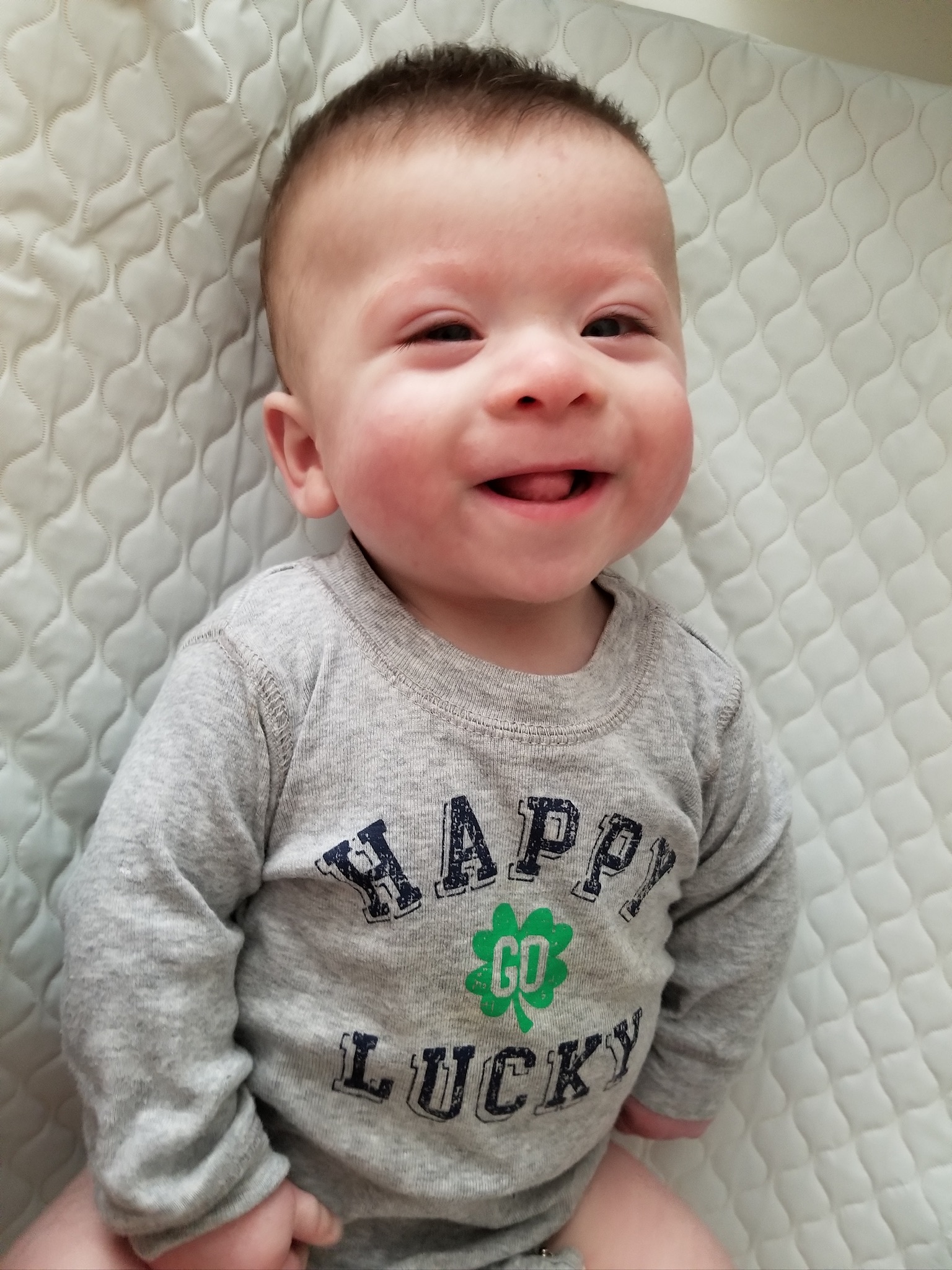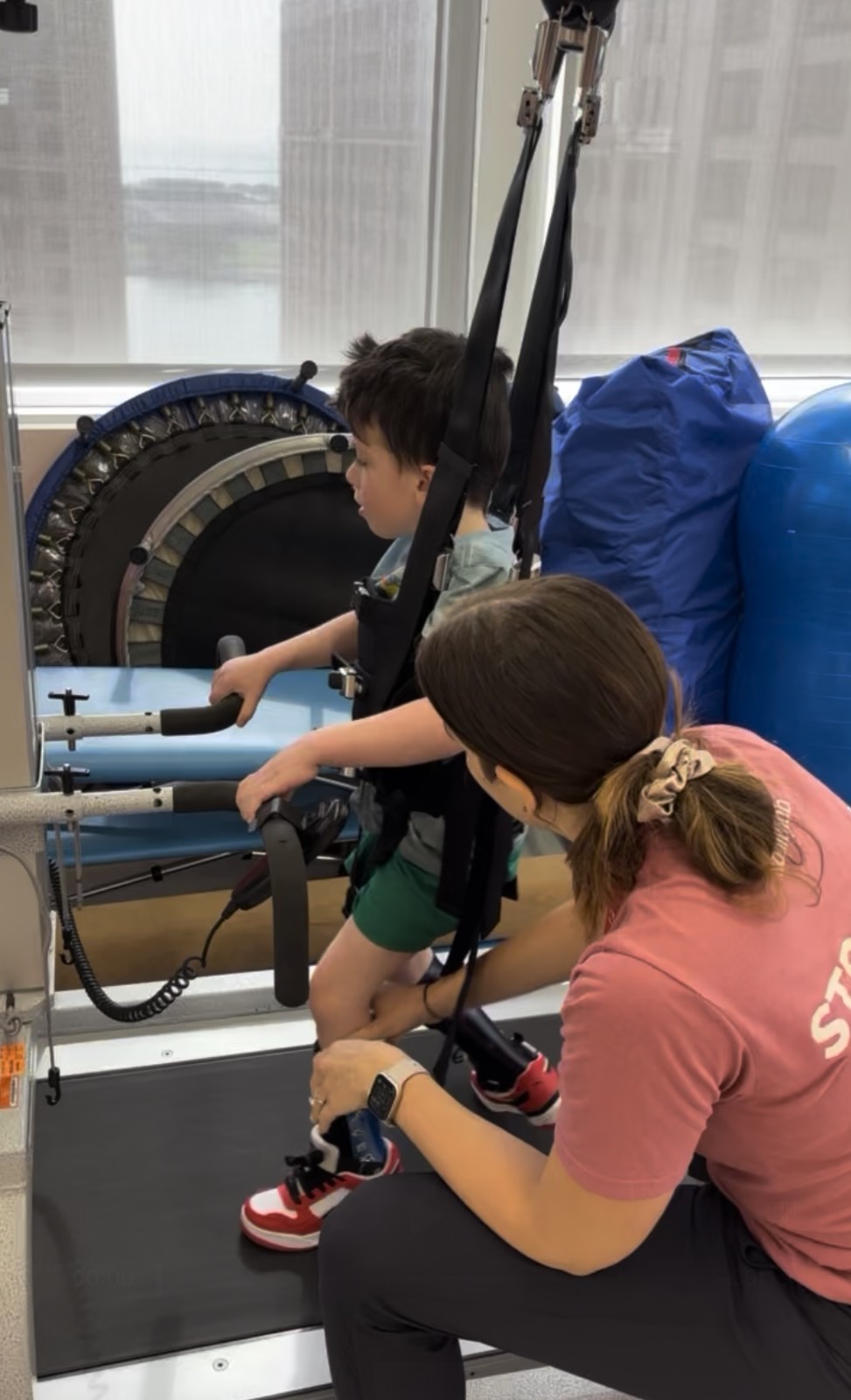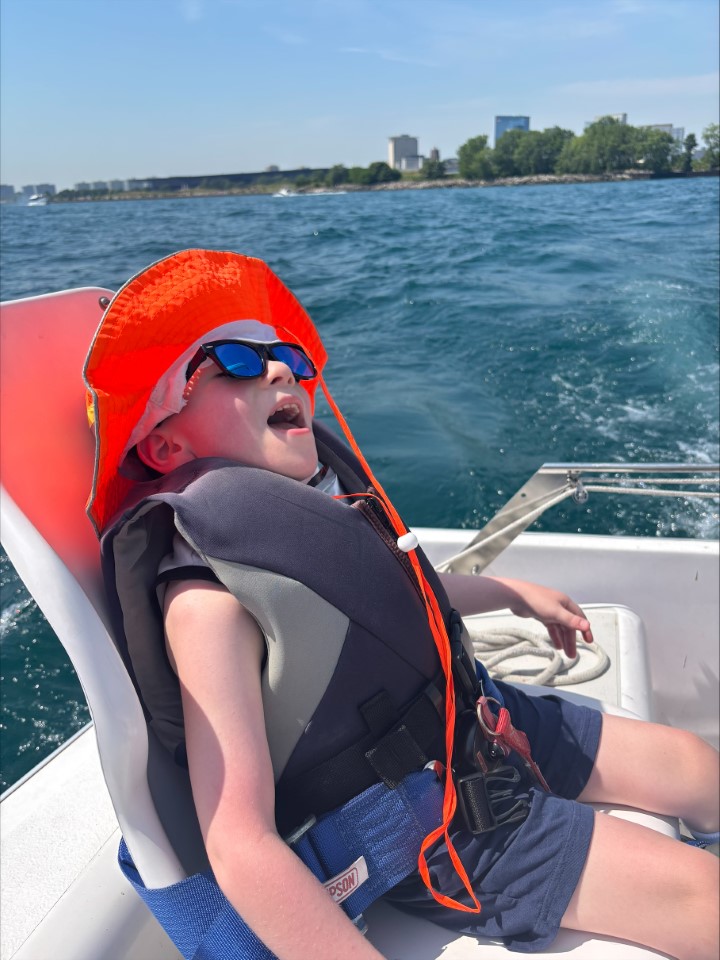Body
At age 7, Declan C. is talkative, inquisitive and already has a developing interest in science. During his recent inpatient stay at Shirley Ryan AbilityLab, Declan indulged his curiosity when — ever observant — he noticed a sign on the elevator that said “Biologics Lab.”
Declan asked, “What’s that?” and his care team sprung into action to coordinate a behind-the-scenes tour of the Biologics Lab — a state-of-the-art space where Shirley Ryan AbilityLab researchers study living cells to gain a better understanding of movement impairments at the cellular level.
During Declan’s day of discovery, he looked at cells under a microscope, explored lab equipment and learned how the brain sends signals throughout the body to help muscles contract and move. Research scientist Andy Domenighetti, PhD, was Declan’s lab “tour guide” and explained how Shirley Ryan AbilityLab researchers are developing new biological approaches to treat neuromuscular disorders such as cerebral palsy (CP).
For Declan and his mom, Cailin, the tour of the Biologics Lab carried special meaning. It was an opportunity to learn more about CP — the condition Declan was diagnosed with at only 18 months old when he first started coming to Shirley Ryan AbilityLab.
Early Detection of CP for Better Patient Outcomes
Body
When Declan was a baby, his pediatrician recommended a CP evaluation due to concerns about Declan’s overall development and stiffness in his legs when he moved.

Cailin brought Declan from their home in western Illinois to Shirley Ryan AbilityLab for an outpatient visit with Ana-Maria Rojas, MD, an attending physician who specializes in the early detection of CP and ongoing care for patients with CP through the growing years. After an evaluation and consultation, Dr. Rojas diagnosed Declan with CP.
Early detection is key for helping kids like Declan achieve better outcomes and participate in early, specialized therapies while the brain is developing rapidly. In fact, after the diagnosis, Cailin said she could start envisioning the tools, resources and interventions that would create “the best possible picture” for Declan.
“It’s hard to find a physician who will be your partner through a life-changing diagnosis like CP,” said Cailin. “Once we started our journey with Dr. Rojas, we immediately talked about what we can do now and what we will we do down the road.”
Declan continued to see Dr. Rojas on an outpatient basis for the first few years of his life, especially to address gross motor dysfunction in his legs due to spasticity — a disruption of normal muscle function in which all the muscles contract at once. Spasticity, common in patients with CP, causes muscle tightness and rigidity that can be very painful and also can interfere with movement and the ability to walk.
Declan participated in physical and occupational therapy in school. By the time he turned 5, he also had benefited from several interventions for CP through Shirley Ryan AbilityLab. He was fitted for his first set of ankle-foot orthoses — ankle braces to help to improve balance, stability and alignment. He also was fitted for a walker so he could “zoom around like any other kid,” according to Cailin.
Declan traveled to Shirley Ryan AbilityLab for serial casting, in which patients wear a series of casts for a period of time to improve range of motion in a particular joint. Dr. Rojas also addressed Declan’s spasticity through medication, phenol blocks and Botox therapy — all with the goal of relaxing his leg muscles to promote movement.
Surgery & Intensive Rehabilitation to Promote Mobility
Body
Even with all of these proactive steps, Cailin could see Declan’s frustration when he couldn’t participate in the same activities that other kids his age could enjoy.
“I started to ask myself, ‘what else is there? Hit me with everything to help Declan,’” she said.
Cailin learned about a surgical procedure called selective dorsal rhizotomy (SDR) that aims to reduce spasticity in the lower limbs. During the procedure, a surgeon cuts and cauterizes the nerve roots in the spinal cord that are causing spasticity — and leaves healthy nerves intact.
Declan was an ideal candidate for an SDR, given his young age and the severity of his spasticity. Cailin spent about a year researching the procedure and getting critical medical advice from Declan’s doctors, including Dr. Rojas. Also, Declan participated in a comprehensive evaluation at Shirley Ryan AbilityLab, including a computerized gait analysis, as part of being considered for SDR.
In the end, Cailin decided to move forward with surgery — with the hope that Declan would see improved mobility and function, reduced pain and an overall improvement in his quality of life.
Declan’s surgery took place at Ann & Robert H. Lurie Children’s Hospital of Chicago, with Dr. Rojas in attendance to consult and keep abreast of Declan’s progress. By all accounts, the procedure was a success, and Declan soon transitioned to Shirley Ryan AbilityLab to begin intensive rehabilitation.
After years of coming to the hospital as an outpatient, this would be Declan’s first time as an inpatient. In typical Declan fashion, he approached rehabilitation enthusiastically.
“Declan always knew that after the surgery he was going to Shirley Ryan AbilityLab. His first words when we arrived were, ‘I’m so excited,’ which made his nurse laugh,” said Cailin. “This place is full of hope and wonder, and it was the only next step for him. After his procedure, I didn’t want him anywhere else.”
Making Great Strides Toward Mobility & Independence
Body
Declan’s goals in physical therapy targeted his functional mobility and overall independence. For example, he worked on activities such as climbing stairs more independently. He also participated in gait training, spending extended time walking on the treadmill with the support of his physical therapist.

“Declan made incredible strides, literally, in rehabilitation,” said Cailin. “He started sustaining longer sessions of movement while his physical therapist guided his body through proper movement patterns, which were essential to reprogram his muscles for optimal mobility.”
Cailin recalls a memorable moment in therapy where Declan stood independently with straight legs to play for a few minutes, with no walker or assistance from a therapist.
“It showed me that, after surgery and rehabilitation, those deep core muscles he couldn’t access before were finally his to command,” said Cailin.
Though Declan’s surgery targeted movement in his lower limbs, one of the unexpected residual effects was improvement to his upper extremities, including increased range of motion. In occupational therapy, Declan worked on hand and finger coordination to build fine motor stamina and strength, giving him greater control over daily tasks that require the use of his hands.
Enthusiastic Participation in Quality-of-life Programs
Body
In addition to physical and occupational therapy — and side adventures like his special day in the Biologics Lab — Declan took advantage of Shirley Ryan AbilityLab’s quality-of-life programs during his inpatient stay, including art and music therapy and recreational therapy activities such as adaptive sailing, boccia ball and biking.

“Declan was able to use a hand-propelled bike to gain strength and confidence, and a member of the recreational therapy team showed him how to use a bicycle that may work for him as he continues to get stronger,” said Cailin.
In recreational therapy, Declan also tackled previously difficult fine motor tasks, like using various video game controllers.
“I was thrilled for him to have so many opportunities to explore all of the things he was restricted from doing before his surgery and to get a glimpse of what he was now capable of,” said Cailin.
Cailin worked closely with Shirley Ryan AbilityLab’s Henry B. Betts, MD, LIFE Center, the hospital’s multimedia educational center that supports patients and families. They connected Cailin to resources, equipment and grant opportunities that would enable Declan to keep making progress when he returned home.
‘A World of Possibilities’ as Declan Meets His Biggest Milestone Yet
Body
To continue capitalizing on his progress post-surgery, Declan transitioned to Shirley Ryan AbilityLab’s Streeterville DayRehab Center in Chicago for physical and occupational therapy five days a week — followed by intensive outpatient therapy — to keep improving strength, endurance and balance.
Today, Declan’s spasticity is greatly reduced — allowing for more fluid, natural movements so he can walk with greater ease and balance with his walker.
Most recently, he met his biggest milestone to date: walking unassisted for the very first time in his life — taking 41 steps on his own.
Once again, Declan’s reaction reflected his tenacity and unflagging optimism:
“We can keep going.”
As Cailin looks to the future, she says that Declan’s determination, hard work, and neuroplasticity — the ability for the brain to adapt and change — will allow him to explore activities and experiences that are now within his reach, such as sports or recreational activities that were previously challenging.
“I want Declan to know what it feels like to be limitless as a kid and to experience the incredible freedom of movement that childhood is meant to offer. I would like him to continue building resilience and determination through his rehabilitation journey. Ultimately, I want my son to have greater independence in all of his activities,” said Cailin. “Declan has been brought into a world of possibilities thanks to Shirley Ryan AbilityLab.”


